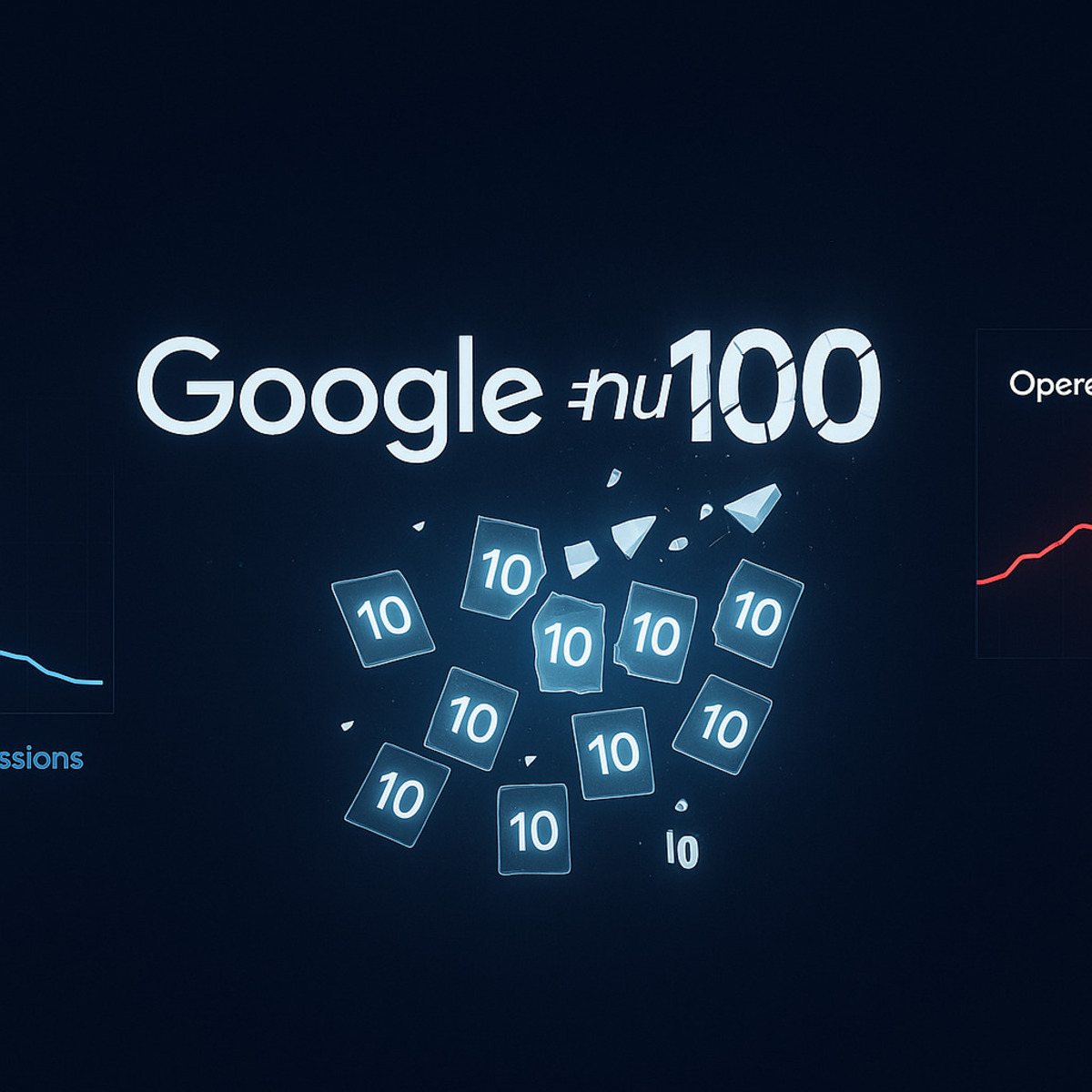Google has disabled the
&num=100search parameter. This change ends the ability for SEO tools to request 100 results at once. The impact is immediate: SEO rank tracking tools are breaking, and operational costs forGoogle SERP scrapingare increasing tenfold. This move also explains the suddendesktop impressions dropin Search Console, revealing long-standing data inflation from bot traffic. This is a deliberate, defensive action by Google, not a test. SEO professionals must immediately re-baseline their data and audit their tools.
Are your SEO rank trackers failing? Have your Google Search Console desktop impressions vanished? You are not alone. The foundation of automated SERP data collection just cracked. Google has quietly, but effectively, killed a core function many SEOs relied on for decades.
What Was the Google &num=100 Parameter?
For over two decades, the Google &num=100 parameter was a simple, yet powerful, tool in the SEO arsenal. It was a URL parameter, a piece of text added to the end of a Google search query. By adding &num=100 to the URL, you instructed Google to return 100 search results on a single page, instead of the standard 10.
This function was the literal backbone of efficient SEO rank tracking. Think about how modern rank tracking platforms work. They must check your position for hundreds or thousands of keywords, daily.
The &num=100 parameter allowed them to do this with relative ease. A single request to Google could capture the entire top-100 landscape for a keyword. This single-request method was fast. It was computationally cheap. It minimized the tool’s footprint, reducing the risk of being blocked by Google.
Now, it is gone.
Sometime in late 2024 / early 2025, Google deprecated this function. It was not announced in a blog post. There was no official warning. It simply stopped working.
Any request using the &num=100 parameter now defaults to a standard, 10-result page. The long-standing ability to pull 100 results in a single, cost-effective query is over. This change is not a minor tweak; it is the demolition of a core mechanism that the entire SEO tool industry was built upon.
The 10x Cost: How This Breaks SEO Rank Tracking
The consequences for SEO tool data collection are mathematically brutal. What once took one request now requires ten.
To track a keyword’s top 100 positions, a tool must now emulate a human user, paginating through the results. It must load page 1, scrape the 10 results, then request page 2, scrape those 10, then page 3, and so on. This must be repeated ten times to gather the same data that one request used to provide.
This represents a 1000% increase in operational load. Let’s be specific about the costs.
- Proxy and IP Costs: Every request must come from a unique IP address to avoid blocks. A tool that needed 1,000 IPs for 1,000 keyword checks now needs 10,000 IPs for the same task. This is a 10x increase in proxy provider bills.
- CAPTCHA Solving: Google’s anti-bot measures trigger more frequently with rapid pagination. Each 10-page request cycle has a higher chance of hitting a CAPTCHA. This means more failed requests and higher costs for human or AI-powered CAPTCHA-solving services.
- Data Processing and Storage: The sheer volume of incoming data (10x the HTML pages) requires more processing power and storage.
- Failure Rates: Scraping 10 pages successfully is far harder than scraping one. The chance of a single request failing (timeout, block, error) is multiplied, leading to incomplete or corrupted
SEO tool data.
For SEO tool companies, this is a financial catastrophe. Their entire SaaS pricing model is based on the old, cheap-request economy. They are now scrambling.
For SEO specialists in Melbourne, digital marketing managers in Sydney, and agencies across Australia, this translates directly to your workflow. Your tools are failing. You see empty dashboards, timeout errors, or wildly fluctuating rank data. Your tool provider is either absorbing a massive loss, frantically re-coding their scraper, or preparing a new pricing plan that will shock you.
Solving the Desktop Impressions Drop Mystery
In parallel with tool failures, a second crisis emerged. SEOs globally began reporting a sudden, sharp desktop impressions drop within Google Search Console.
The panic was understandable. A 30%, 50%, or even 70% drop in desktop impressions overnight suggests a catastrophic penalty or a massive loss of human traffic. But the traffic and conversion metrics in Google Analytics and internal reports were not matching. Revenue was stable, but GSC impressions had fallen off a cliff.
The truth is more complex. This drop is likely not human traffic at all. It is the sudden, mass removal of bot impressions from your data set.
Here is the connection:
- The
SEO rank trackingindustry, by its nature, is a massiveGoogle SERP scrapingoperation. - To check rankings, these tools must “visit” the SERP. They do this millions of times per day.
- They almost always use desktop user-agents (mimicking a desktop browser) and run from data-center or residential proxy IPs.
- For years, Google Search Console’s filters were not perfect. A significant portion of this automated bot traffic was being counted as a legitimate “impression” for every site that appeared on the scraped page.
- If your site ranked for 10,000 keywords and your tool checked them daily, that was 10,000 bot impressions per day added to your GSC data.
The removal of the Google &num=100 parameter made this scraping 10x harder and more expensive. Many large-scale scraping operations, especially lower-budget ones, stopped instantly. They could no longer afford the 10x cost.
When those bots stopped, the “impressions” they generated vanished from GSC.
The “lost” impressions were never real users. You are now seeing a more accurate, cleaner, and lower baseline for your actual human desktop audience. Your historical data was, in all likelihood, permanently inflated.
Google’s Defensive War on SERP Scraping
This was not a random test. This is a deliberate, defensive, and strategic move by Google. The Google &num=100 parameter was a liability. It was a relic from an older, simpler internet.
Today, Google is not just fending off SEO tools. It is in a full-scale data war. The primary antagonists are AI companies.
These companies are desperately scraping trillions of pages to train their next-generation large language models. Google’s search results are a prime target. They are curated, high-quality, and neatly organized.
This industrial-scale scraping places an immense, unwanted strain on Google’s infrastructure. It costs them millions in bandwidth and processing power. It also represents a direct theft of their intellectual property.
Google’s primary motive is to fight back. This change is a financial weapon. By removing the &num=100 function, Google makes mass data harvesting financially unviable. They have forced a 10x cost increase on their enemies.
The entire SEO industry and our suite of SEO tool data platforms are simply collateral damage. We are small fish caught in a war between whales. Google is protecting its core data asset, and the old, easy access we enjoyed for decades is the price of that protection.
Not a Bug: Why This Google Search Parameter Change is Permanent
Some in the SEO community are holding out hope. Forums and social media are full of theories. They argue this is a temporary test. They claim it’s a minor bug that a Google engineer will eventually fix.
This optimism is misplaced and dangerous for planning.
A bug would be inconsistent. It would appear and disappear. A/B tests are, by definition, limited to a small percentage of queries or regions.
This Google search parameter change is the opposite. It is global, uniform, and absolute. It was a digital flip of a switch. Every tool, every user, and every data center IP across the planet saw the change at the same time.
The 10x cost implication is not an accident. It is precise, surgical, and economically motivated. It is a move designed to inflict maximum financial pain on automated systems. This points directly to a permanent, high-level, strategic policy decision.
Do not wait for a fix. This is the new normal.
Your Action Plan: How to Adapt to the New Data Reality
The era of cheap, granular, 1-100 SEO rank tracking is over. SEO professionals, data analysts, and marketing managers must adapt.
First, you must audit your SEO rank tracking tools immediately. Open a support ticket. Ask your provider directly how they are handling this change. Are they paginating 10 times? Are they limiting tracking to the top 20 or 30? What will happen to your monthly bill? You need answers now.
Second, you must re-baseline all your performance metrics. Go into Google Search Console and create an annotation for the date this desktop impressions drop occurred. This is your new “Year Zero” for impression data. All historical reports and year-over-year comparisons are now invalid. You must explain this data integrity issue to your clients and stakeholders.
Third, SEOs in Australia and worldwide must prepare for a future with more expensive and restricted access to SERP data. The Google &num=100 parameter is just the first step. Google will continue to lock down its data.
Your strategy must evolve. Move away from obsessing over daily rank fluctuations. Focus on broader trends, topic clusters, content quality, and first-party user data. The game has changed.

